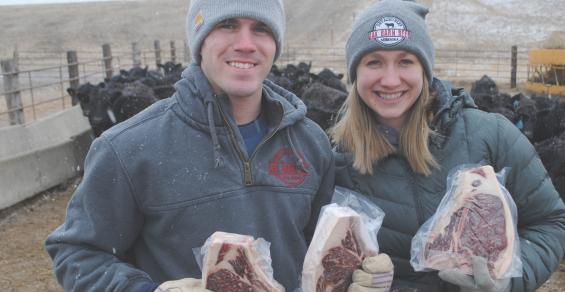A couple of years ago, a big day of business for Oak Barn Beef, based in West Point, Neb., would have been shipping out five boxes of beef bundles. But now, the company — owned and operated by Hannah and Eric Klitz — ships out 175 boxes of beef on a good day, shipping to all 50 states.
The goal of Oak Barn Beef is not only to ship high-quality, home-raised beef to loyal customers, but also to tell the story of their farm and how their beef gets from the farm to the table. Supply chain issues in the early days of COVID-19 boosted their business, like so many on-farm direct meat suppliers.
They went from seven beef box subscribers before COVID-19 to almost 100 last year. But this beef business boom also opened opportunities for the young, dynamic farm couple to engage with new customers about agriculture and their operation.
Groundwork
For Hannah, the direct beef business all started with the University of Nebraska Engler Entrepreneurship program and a dream. She and Eric met as high school seniors interviewing for a scholarship. They both participated in Engler, and Hannah was also a Nebraska Beef ambassador.
As an ambassador, she recognized the disconnect between producers and consumers and had the opportunity to discuss cattle-raising practices with those who weren’t familiar with the farm. This experience solidified her goal of bringing consumers not only quality beef, but also helping them understand where their food is coming from.
“So many good things come out of Engler,” Hannah says. “It taught us how to think outside the box. During our freshman year, we were given $50 to go out and start a business. We were able to learn more from mistakes and failures, and how to think differently and have that mentality.”
Growing up on the farm, Hannah’s father had sold quarters, halves and whole beef, so she learned about direct marketing through those experiences. She sought out her own internship during college with a farm-to-table beef, pork and lamb company in northern California, and the company shared insights into their business model with her.
“I decided that this was the business model I was interested in,” Hannah says. “That’s where we pivoted from the idea of selling beef shares to shipping beef, individual cuts, beef bundles and subscription boxes.”
The target audience for their beef has also shifted a bit. “We thought our target audience would be mothers in urban communities,” Hannah explains, “who wanted to be connected to the food they were feeding their families.”
Over time, they certainly have served that market, but they also found new customers in older, retired gentlemen, for instance, who really missed eating good-quality beef that reminded them of their childhood on the farm.
Unique about Oak Barn
Oak Barn Beef takes a little more time to process its meat products. That’s because its beef products are dry-aged, which Hannah says “gives it time to mature, like a fine wine or cheese, because this process gives natural enzymes time to break down muscle tissue for a more tender and flavorful product.”
The couple also DNA-tests calves for genetics that offer those same meat qualities of tenderness and flavor. “My dad has been DNA-testing his cattle herd since 2006 for maternal traits,” Hannah says, “like milking ability and longevity.”
Understanding the actual genetic makeup of the animals, and their genetics for the tenderness and marbling genes, makes for better-tasting beef, she adds.
They purchase calves at weaning, focused on the same priorities for tenderness and superior genetics when it comes to taste factors. The animals are transported to their family farm at West Point, where they are fed for finishing.
With processing slots so difficult to come by since the onset of COVID-19, Hannah and Eric used three different USDA-inspected locker plants for processing in 2021. In October 2020, they converted an old hog barn on the farm of Eric’s parents, with a walk-in freezer, storage and shipping facility.
While this facility has served the company well, dreams for the business have outgrown the space. Eric and Hannah recently bought a new headquarters building in West Point, and plan to open their own storefront this summer.
“We hope to expand our offerings to allow people to pick up beef, shop other farm products and make it a destination when they happen to be in the area,” Hannah says. “With a larger storage and distribution area, we hope to improve our shipping practices and serve our customers better.”
Engler helped in the business model development, and with marketing knowledge, which Hannah says is mostly self-learned. They do mostly digital marketing, email and mailers, focusing on social media and optimization of those digital tools as e-commerce trends continue to expand.
Because both Eric and Hannah also have off-farm jobs, they stay extremely busy, with the fourth quarter of the year as the busiest, and February and March a little slower. They have groups of cattle that are finishing at different times of the year, so they can fill demand as it is needed, all year. They have also had to master the logistics of shipping a perishable product, which took some time to figure out.
But today, with the prospect of opening a new storefront later in the year, Hannah and Eric and Oak Barn Beef are primed for more growth. Since the start, they have doubled their business year over year, and they see no reason for that to slow down.
Learn more about Oak Barn Beef at oakbarnbeef.com.
5 things
While developing their own direct beef marketing business, Hannah has also consulted and helped other agriculture startups, using her own experiences. She’s developed expertise in this particular realm, so we asked her to share her five best meat business startup tips:
Start small! Selling beef or other species shares (quarters, halves and wholes) is a great place to start.
Focus on figuring out your costs right as you start, so you know your exact cost per pound.
Learn as much as you can about marketing. I learned most from audiobooks and podcasts.
Shipping is a powerful addition to the business, but it also adds a lot of costs. Focus on your local market first to keep costs down.
You learn as you go. You will never be able to know everything before starting, so take the first step and begin.
The operation in West Point, Neb., keeps expanding, including adding a storefront this summer.




